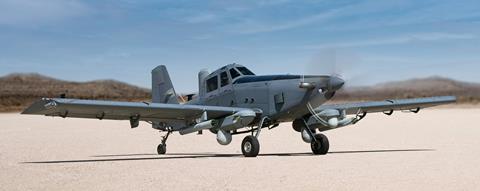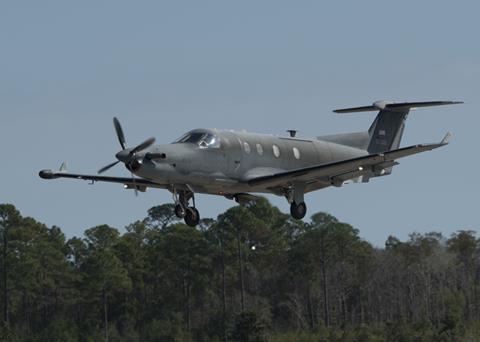US Special Operations Command (SOCOM) is on track to receive the first example of a new close-air support turboprop in the coming weeks.
The OA-1K, a militarised crop duster manufactured by Air Tractor and modified by L3Harris was selected by SOCOM in 2022 as the winner of the Armed Overwatch competition.
That programme sought to replace the Pilatus U-28A Draco turboprops operated by US Air Force special-mission aviators as intelligence, surveillance and reconnaissance (ISR) aircraft.
Less than two years after prevailing in the Armed Overwatch contest – beating out rivals Textron and Sierra Nevada – L3Harris tells FlightGlobal it will soon deliver the first two OA-1Ks to SOCOM.
“We have four aircraft that are in production in Tulsa, Oklahoma,” says Jason Lambert, president of ISR at L3Harris. “We have additional two aircraft that are in Waco, Texas going through development and certification flight tests.”
Lambert spoke with FlightGlobal on 8 April at the 2024 Special Operations Forces Week conference in Tampa, Florida.
The offering that became the OA-1K is derived from a commercial turboprop already available around the world – Air Tractor’s AT-802U type. L3Harris markets the militarised version of the aircraft as the AT-802U Sky Warden.
The first two OA-1K aircraft delivered to SOCOM will be trainer aircraft, which Lambert says should be turned over before the end of the second quarter. L3Harris will begin delivering operational OA-1Ks by the end of 2024.
SOCOM’s current programme of record covers 75 examples of the new turboprop, with 25 already under contract, according to Lambert.
Auditors at the US Government Accountability Office (GAO) have criticised that fleet target, which is worth up to $3 billion for L3Harris. In a December report, the GAO claimed SOCOM failed to properly assess its latest operational needs before committing to an Armed Overwatch fleet of 75 aircraft.
“This analysis wasn’t completed before the [Department of Defense] decided to buy the planes,” the GAO says. “DoD’s special-operations mission requirements have also changed in recent years, and it hasn’t evaluated if it still needs all 75 planes.”
While SOCOM has no plan to curtail Armed Overwatch, the officer managing the acquisition says he is “100% onboard” with the GAO’s questions and is working to address issues raised.
Also speaking at SOF Week, US Air Force Colonel Justin Bronder – the head of SOCOM’s fixed-wing aircraft procurement office – said the command is open to modifying the Armed Overwatch requirements, which were conceived before Washington’s recent pivot to focus on countering near-peer competors.
However, Bronder insists the USA still needs a loitering platform to provide special-operations troops with low-altitude, close-air support.
“That’s obviously much more cost-effective than trying to get a stack of F-16s, and AWACS and… Strike Eagles up there,” he notes, referencing the USAF’s primary strike fighter aircraft and its airborne warning and control system jets.
Unlike the USA’s other fixed-wing fighters, the OA-1K fleet will only support special operations forces. Although the type is billed as successor to the U-28 reconnaissance aircraft, Bronder is clear the OA-1K’s primary mission will be close-air support. “It’s not a replacement for any ISR platforms.”
The OA-1K was designed as a rugged, affordable close-air-support platform. But the US military’s focus shift away from preparing for low-intensity conflicts, and toward countering modern industrial adversaries like Russia and China, has raised questions about the suitability of a turboprop that flies low and slow.
“Geopolitical changes since SOCOM established the acquisition target in 2019, such as the US withdrawal from Afghanistan and leadership changes in African countries, may affect where and how these aircraft can be used in the future,” the GAO report noted.
While survivability concerns have been central to other fleet decisions – such as the USAF moving to retire its Fairchild Republic A-10 ground-attack fighters and the US Army cancelling its next-generation scout helicopter – SOCOM is standing by the nascent OA-1K.
“It comes with a baseline suite of some countermeasures,” Bronder says. “And then we’re obviously working very closely with our operational counterparts to identify what improvements that needs to stay relevant and ready in future environments.”
Bronder, also a USAF flight-test engineer, predicts SOCOM will continue operating in what he calls “conflict on the margins” of the so-called “great-power competition” between Western allies and the authoritarian bloc led by Russia and China.
Such environs will be more favourable to a rugged, cheap and flexible platform like the OA-1K, the argument goes.
While L3Harris declines to reveal plans for countermeasure improvements, citing operational security, Lambert says the aircraft’s open-architecture operating system is “very flexible and allows for other applications to be plugged in”.
That could include new defensive features, improved ISR capabilities or the addition of precision strike weapons. “We’re always looking at how we can… make the platform even stronger for its mission,” he adds.
As L3Harris ramps toward its target OA-1K production rate of 16 aircraft annually, Lambert says the company is aggressively pursuing overseas sales of the turboprop.
“Our plan would be to keep the line hot and running… To offer build slots for international parties towards the end of the string for the SOCOM customer,” he says.
The company has received US State Department approval to market the new aircraft in 12 countries, Lamber notes, with another dozen locations currently under review for regulatory approval.
Air Tractor has operations in 30 countries, according to Lambert, providing a “natural sustainment base”, in addition to generating fewer concerns about sensitive technology.
L3Harris modifies completed AT-802s for military applications, meaning final products can be tailored to comply with export restrictions and customer requirements.
Cirium data shows that AT-802 series aircraft are already in service with the air forces of Jordan and the United Arab Emirates.













